

Finding a safe and healthy community for retirement can enhance the quality of life for senior citizens.
Just over 49 million U.S. residents are aged 65 years and older. According to the U.S. Census Bureau, this figure will grow to over 80 million come 2050, and the age group will increase from 14.1% of the U.S. population to 20.9%. Knowing which U.S. counties are most suitable for a retiree’s needs can help those considering retirement options. Retiring in the right place can ensure a happy and healthy experience in the latter stage of life.
To find the healthiest counties for retirement, 24/7 Wall St. compiled a wealth of data for counties with significant elderly populations from County Health Rankings & Roadmaps, a Robert Wood Johnson Foundation and University of Wisconsin Population Health Institute joint program.
Click here to see the healthiest communities for retirement.
Click here to read our detailed findings and methodology.
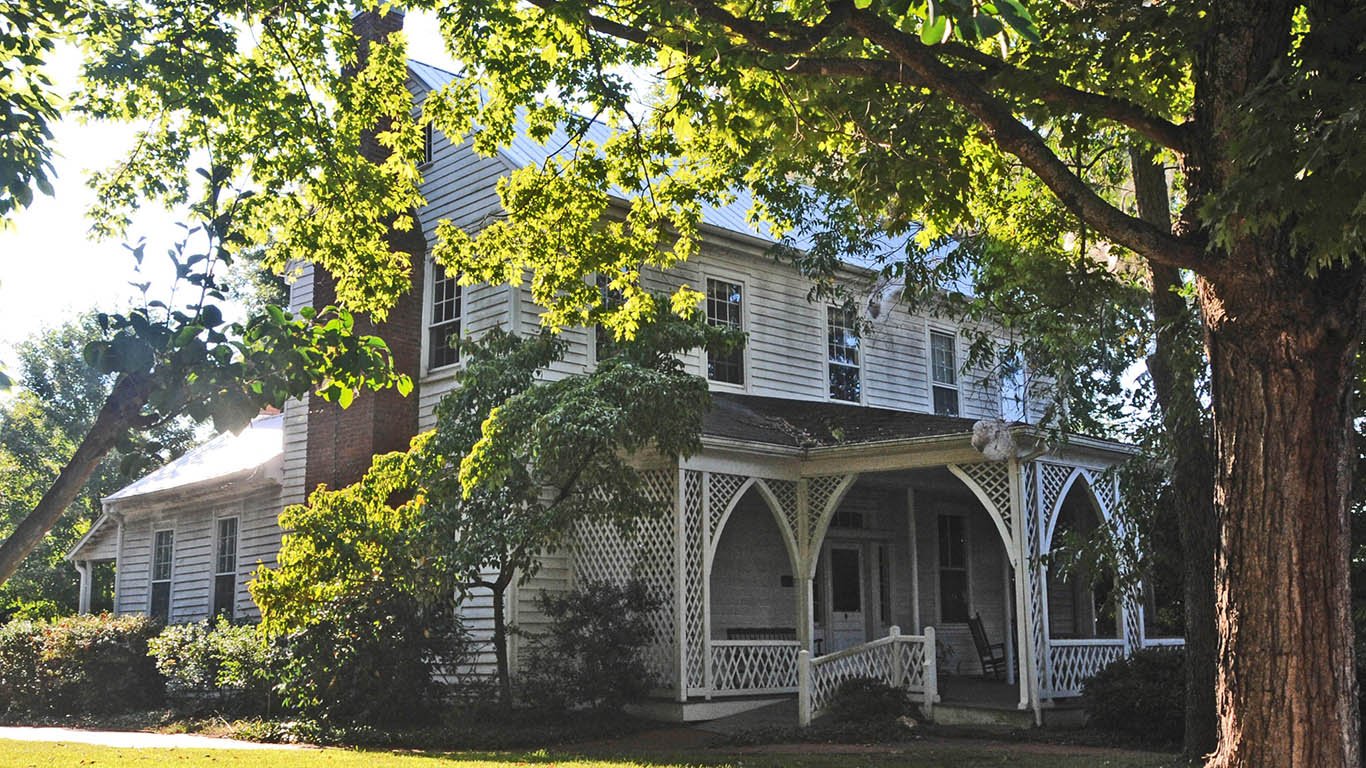
25. Chatham County, North Carolina
> Population: 67,431
> Pct. of population 65+: 22.6%
> Avg. retirement income: $29,998
> No. of primary care physicians: 65
The population of Chatham County aged 65 and over grew by 2.8% over the past year due to migration from out of state, more than twice the average rate of 65 and older migration across all counties. Located in the Durham-Chapel Hill metro area, which includes both Duke Hospital and UNC Hospitals, Chatham County retirees have access to some of the best health care in the country. Some 90% of diabetic Medicare patients aged 65 to 75 receive annual tests that evaluate their long-term control of blood glucose concentrations, and 70% of female Medicare enrollees aged 65 to 67 receive breast cancer screenings biennially, both of which larger than the corresponding national shares. Additionally, Pittsboro, the county seat, became a North Carolina Certified Retirement Community in 2013 — a designation that acknowledges the area’s exceptional quality of living for seniors.
[in-text-ad]

24. Transylvania County, North Carolina
> Population: 32,928
> Pct. of population 65+: 27.6%
> Avg. retirement income: $25,207
> No. of primary care physicians: 25
One of four North Carolina counties on this list, Transylvania has a relatively large senior citizen community. Some 27.6% of the county population is at least 65 years old, more than double the 14.1% national share. The 65-year and older population grew by 2.6% due to migration from out of state in the past year alone, more than double the national rate of 1.1%. Senior citizens may be attracted to Transylvania County due to its surroundings, which include waterfalls, mountains, and numerous recreational opportunities. More than 80% of the county population has access to places for physical activity such as parks and recreational facilities, which may give residents incentive to engage in exercise regularly.

23. Indian River County, Florida
> Population: 142,866
> Pct. of population 65+: 29.5%
> Avg. retirement income: $30,527
> No. of primary care physicians: 104
Some 29.5% of residents in Indian River County are 65 years old and over, one of the largest shares of any U.S. county. Indian River is also one of the healthiest counties nationwide. Only 24.5% of adult residents are obese, far less than the 28.0% national obesity rate. For every 100,000 residents, 6,686 years of life are lost annually due to people dying before the age of 75. To compare, the average annual rate among the 500 oldest U.S. counties is approximately 7,500 years of life lost due to premature death per 100,000 residents.

22. Cape May County, New Jersey
> Population: 95,805
> Pct. of population 65+: 23.3%
> Avg. retirement income: $27,453
> No. of primary care physicians: 57
The 65 and older population in Cape May County grew by 2.3% over the past year due to inbound out-of-state migration, more than twice the national average growth rate. New retirees may come to enjoy the county’s numerous beaches and golf courses. While counties with older populations are often less healthy, Cape May County residents have healthier behaviors than the average American, leading to better health outcomes. Just 14.2% of adults in the county smoke, and only 21.8% do not exercise regularly, better than the national rates of 18.0% and 22.0%, respectively. Cape May County seniors may also have better access to health care. Some 70% of female Medicare enrollees in the county aged 65 to 67 receive breast cancer screenings biennially, more than the 63% national share.
[in-text-ad-2]

21. Lee County, Florida
> Population: 663,675
> Pct. of population 65+: 25.6%
> Avg. retirement income: $30,564
> No. of primary care physicians: 429
Lee County attracts more senior citizens every year than nearly any other U.S. county. Lee County’s 65 and older population grew by 4.5% over the past year due to the influx of new senior citizens from out of state, more than four times the national average. These newcomers are joining one of the healthiest old-age communities in the country. Just 6,620 years of life are lost due to people dying before the age of 75 per 100,000 Lee County residents annually, approximately 900 years less per 100,000 than the average rate among the 500 counties with the oldest populations in the United States.
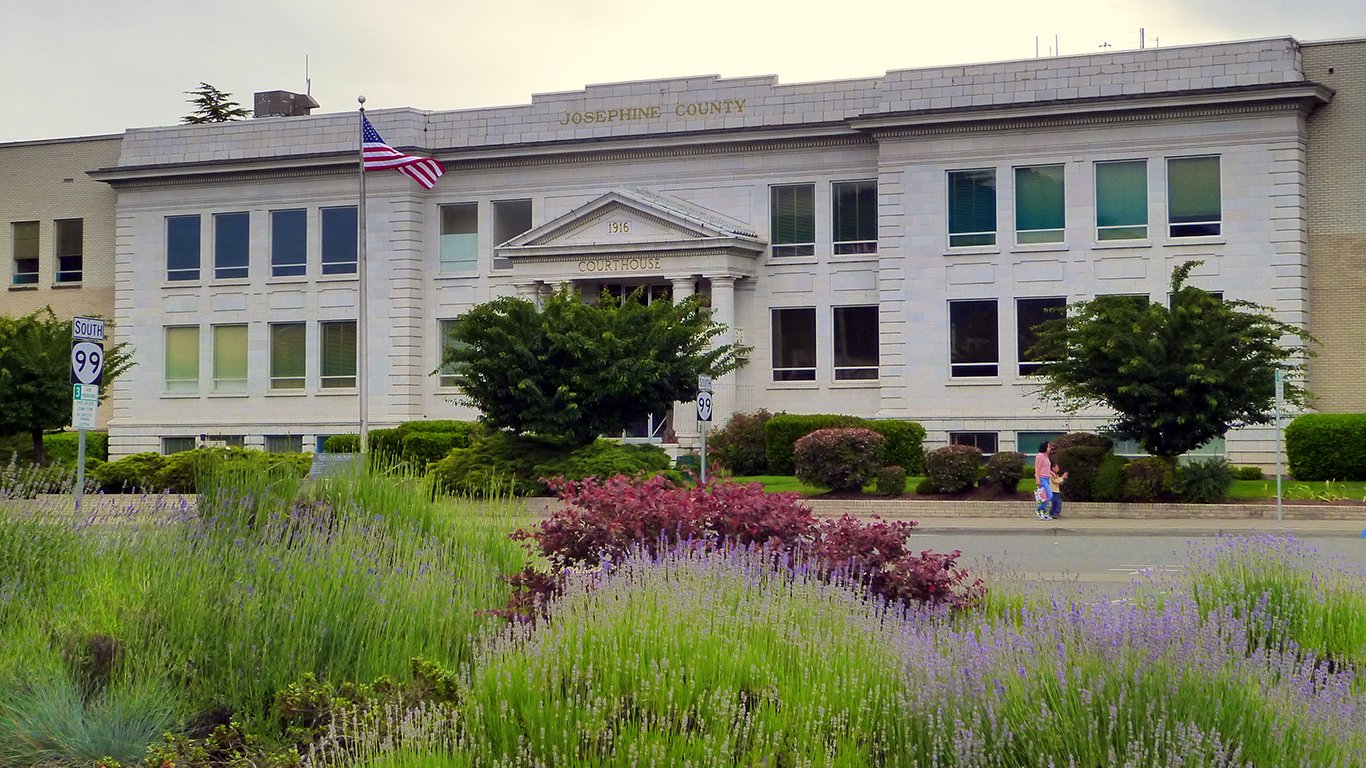
20. Josephine County, Oregon
> Population: 83,409
> Pct. of population 65+: 24.1%
> Avg. retirement income: $22,099
> No. of primary care physicians: 72
Senior citizens in this West Coast county have access to a high concentration of health care providers. There are 86 primary care physicians, 76 dentists, and 620 mental health providers per 100,000 residents in Josephine County, among the most of any county. By comparison, nationwide there are 75 primary care physicians, 66 dentists, and 200 mental health providers per 100,000 Americans. Additionally, the population as a whole exhibits relatively healthy behaviors. Only 20% of the Josephine County population is physically inactive and 17% drinks excessively, both below the respective national rates of 22% and 18%.
[in-text-ad]

19. Brunswick County, North Carolina
> Population: 115,926
> Pct. of population 65+: 25.6%
> Avg. retirement income: $29,567
> No. of primary care physicians: 56
The 65-year and over population in Brunswick County, North Carolina has increased by an astounding 59.1% from 2010 to 2016 — more than triple the nationwide corresponding population growth rate of 21.6%. Over the past year, this population in Brunswick grew by 3.4% due to out-of-state migration, well above the average growth rate due to migration across counties of 1.1%. One factor attracting retirees to Brunswick County may be the area’s quality health care. Of diabetic Medicare patients aged 65 to 75, 92% receive tests that evaluate their long-term control of blood glucose concentrations annually, well above the national rate of 85%. Additionally, 79% of female Medicare enrollees aged 65 to 67 receive breast cancer screenings biennially, far more than the 63% national figure. Brunswick County residents are also relatively active. Only 20.4% of the adult population is physically inactive, below the 22.0% national inactivity rate.

18. Yavapai County, Arizona
> Population: 215,996
> Pct. of population 65+: 27.2%
> Avg. retirement income: $25,189
> No. of primary care physicians: 136
Founded in 1864, Yavapai County is one of the oldest in Arizona. Yavapai also has one of the oldest populations in the state. Some 27.2% of the population is 65 years or older, the second largest share in Arizona and one of the largest of any county nationwide. The 65-and-older population grew 3.2% due to the influx of senior citizens from out of state in the past year, nearly triple the 1.1% national average. Newcomers may be attracted to the area for its healthy population. Only 20.4% of the adult population is physically inactive, less than the 22.0% national figure. Also, a relatively small percentage of county adults smoke and drink excessively, at 14.4% and 15.3%, respectively. To compare, 18.0% of adults nationwide smoke and drink excessively. Only 25.3% of the adults population in Yavapai County is obese, below the the national adult obesity rate of 28.0%.

17. Curry County, Oregon
> Population: 22,338
> Pct. of population 65+: 30.5%
> Avg. retirement income: $24,056
> No. of primary care physicians: 16
Curry County has attracted more senior citizens over the past year than nearly any other county.
The 65 and older population grew by 3.8% over the past year due to inbound migration from out of state, well above the national average of 1.1%. Currently, residents who are 65 and over comprise 30.5% of the county’s population, more than twice the 14.1% national share. One pull factor for retirees may be the area’s numerous recreational opportunities and healthy population. Some 94.3% of the population has access to opportunities for physical activity such as parks and recreational facilities, well above the national share of 84.0%. Only 16.9% of adults in the county do not exercise, one of the smallest shares nationwide.
[in-text-ad-2]

16. Ravalli County, Montana
> Population: 40,823
> Pct. of population 65+: 21.9%
> Avg. retirement income: $20,041
> No. of primary care physicians: 27
Located in Montana’s Bitterroot Valley, Ravalli County is an attractive destination for retirees. Over the past year, the county’s 65-and-over population grew 2.1% due to the influx of seniors from out of state, nearly twice the national average. Today, 21.9% of the Ravalli County population is at least 65 years old, far more than the 14.1% national figure. Ravalli County is also one of the healthiest counties in the country. According to the CDC, just 8.9% of adult residents in the county have diabetes, which is less than nearly any other county. Ravalli County residents are also relatively active, with only 20% of adults reporting physical inactivity, less than the nationwide inactivity rate of 22%.

15. Sumter County, Florida
> Population: 108,501
> Pct. of population 65+: 50.9%
> Avg. retirement income: $31,364
> No. of primary care physicians: 39
Over the past year, the 65-and-over population in Sumter County grew 5.6% due to the wave of inbound seniors from out of state, nearly the most of any U.S. county. Many incoming retirees are likely moving to The Villages — the largest retirement community in the United States — which has rapidly expanded in recent years. Today, the 65 and older population comprises 50.9% of Sumter County’s population — the largest share of any U.S. county. One advantage of living in Sumter County may be access to the area’s quality health care system. Some 84% of female Medicare enrollees aged 65 to 67 received a breast cancer screening in the past two years, more than the national average of 63%. Additionally, 90% of diabetic Medicare enrollees ages 65 to 75 receive annual tests that evaluate their long-term control of blood glucose concentrations. For perspective, this figure surpasses the national average of 85%.
[in-text-ad]

14. Henderson County, North Carolina
> Population: 109,719
> Pct. of population 65+: 23.9%
> Avg. retirement income: $22,858
> No. of primary care physicians: 97
Henderson County is a top destination for retirees. Over the past year, the 65-and-over population grew 2.7% from out-of-state migration, more than twice the 1.1% national average. Henderson County is also one of the healthiest counties nationwide, and seniors in the area may have greater access to medical care than in most of the country. Only 9.9% of adults have diabetes, among the least of any U.S. county. Approximately 89% of residents 65 to 75 with diabetes on Medicare receive tests that evaluate their long-term control of blood glucose concentrations annually, more than the 85% national figure. In addition, 70% of women aged 65 to 67 received a mammogram in the past two years, more than the nationwide corresponding share of 63%. The large share of seniors receiving preventive care may be partially due to the high concentration of health providers in the area. There are 87 primary care physicians for every 100,000 residents, well above the national concentration of about 76 physicians per 100,000 Americans.

13. Vilas County, Wisconsin
> Population: 21,355
> Pct. of population 65+: 28.2%
> Avg. retirement income: $25,187
> No. of primary care physicians: 15
Vilas County is home to one of the largest elderly populations in the nation with 28.2% of the county’s population 65 years and older. In the past year, the older population grew by 2.0% from inbound out-of-state migration, about twice the comparable rate across all counties. Seniors in Vilas County have access to a high concentration of health practitioners. There are about 108 dentists per 100,000 residents, nearly twice the the national concentration of 66 dentists per 100,000 Americans. About 90% of diabetic Medicare patients aged 65 to 75 receive HbA1c, or tests that evaluate their blood glucose concentrations, on an annual basis. This is above the comparable rate nationwide of 85%. Similarly, the share of female enrollees 65 to 67 receiving a mammogram every two years is 76% versus the nationwide share of 63.0%.
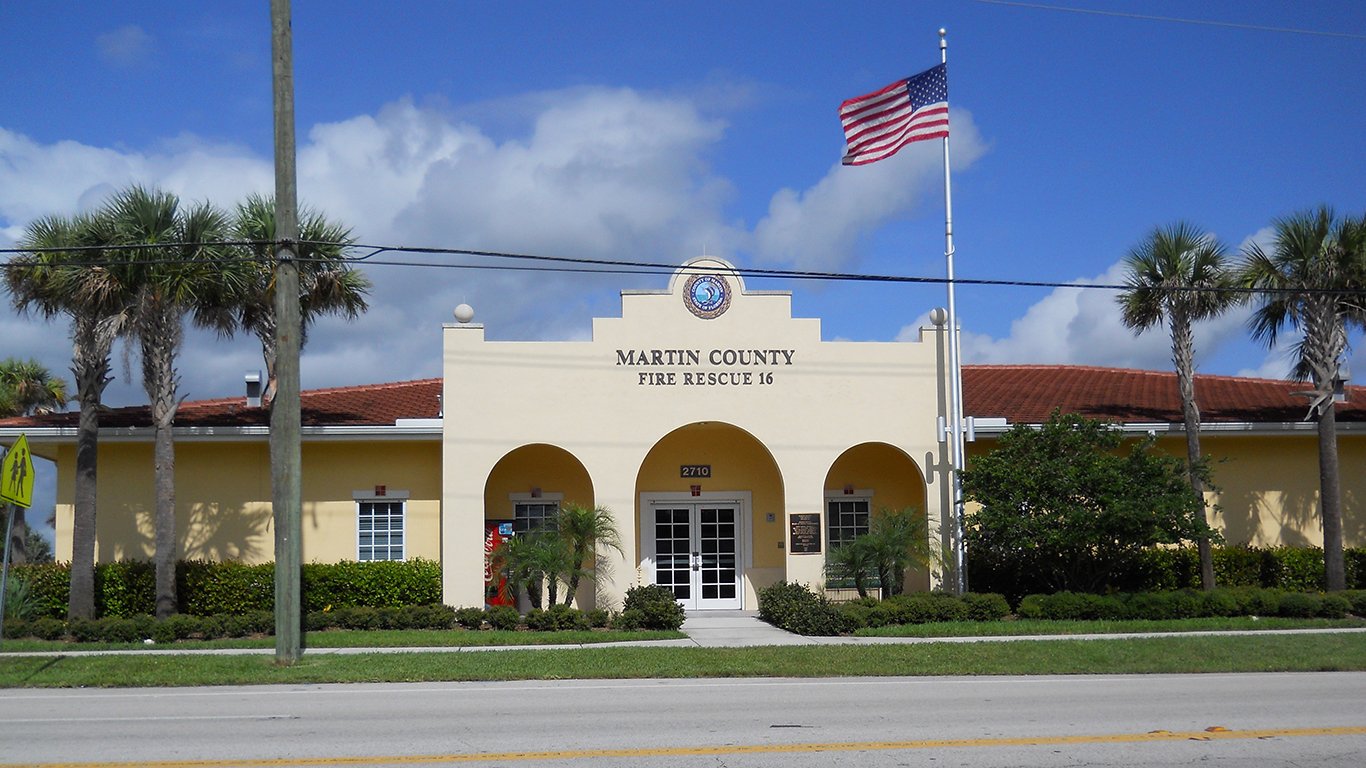
12. Martin County, Florida
> Population: 151,586
> Pct. of population 65+: 28.8%
> Avg. retirement income: $30,388
> No. of primary care physicians: 107
The 65-and-over population in Martin County grew by 4.1% over the past year due to inbound migration, more than nearly any other county. Perhaps the warm weather, numerous beaches, and 75 parks draw retirees into the county. The average retirement income in Martin County is $30,388 annually, one of the largest of any U.S. county. A majority of residents in this community enjoy access to recreational facilities, specifically 95%, more than the national average of 84%. In addition to the greater access to gyms and outdoor activities, Martin County residents are relatively active, and the area has one of the lower obesity rates in the nation. Only 21.3% of adults in the county are obese, much less than the national adult obesity rate of 28.0%.
[in-text-ad-2]

11. Clallam County, Washington
> Population: 72,397
> Pct. of population 65+: 26.2%
> Avg. retirement income: $27,266
> No. of primary care physicians: 64
Clallam County is located in the Olympic Peninsula of Washington state. More than 1 in 4 county residents are at least 65 years old, one of the largest shares of U.S. counties. The age cohort grew by 1.9% due to the inbound migration of out-of-state seniors over the past year, far outpacing the 1.1% national rate. According to Port Angeles — the county seat — seniors move to Clallam County for the area’s scenic beauty and recreation opportunities. Only 18.8% of adults in the county do not exercise, far less than the 22.0% national average. The county is also one of the healthiest in the nation. Just 6,706 years of life are lost due to people dying before the age of 75 per 100,000 Clallam County residents annually, approximately 800 years less per 100,000 than the average rate among the 500 counties with the oldest populations in the United States.

10. Palm Beach County, Florida
> Population: 1,378,806
> Pct. of population 65+: 22.4%
> Avg. retirement income: $29,451
> No. of primary care physicians: 1,109
The origins of Palm Beach County’s status as a retirement community date back to World War II, when thousands of U.S. veterans settled in the area after training nearby. Retirees flocked to the area as developers built up the region’s real estate, and they continue to move to Palm Beach in droves today. The county’s 65-and-over population grew by 2.4% in the past year due to migration from out of state, more than twice the 1.1% comparable national growth rate for the age cohort. While older populations tend to have lower health outcomes, Palm Beach is one of the healthier counties in the country. Just 21.5% of adults are obese, far less than the 28.0% U.S. figure. Additionally, there are fewer years of life lost due to premature death per capita in Palm Beach than in a majority of counties.
[in-text-ad]

9. Douglas County, Nevada
> Population: 47,259
> Pct. of population 65+: 23.5%
> Avg. retirement income: $32,444
> No. of primary care physicians: 32
The 65-and-over population in Douglas County increased by 2.8% over the past year due to out-of-state migration, more than a majority of counties. Today, 23.5% of the county’s population is at least 65 years old, far more than the 14.1% national share. Douglas County residents also have some of the best health behaviors and outcomes in the country. Just 17% of adults do not exercise regularly, far less than the 22% national inactivity rate. Additionally, just 8% of Douglas County adults have been diagnosed with diabetes, one of the smaller shares nationwide.

8. Sarasota County, Florida
> Population: 392,038
> Pct. of population 65+: 33.2%
> Avg. retirement income: $32,420
> No. of primary care physicians: 304
The eighth healthiest retirement community in the nation is Sarasota County, located in the Sunshine State. Palm trees paired with beaches at the Siesta Key make Sarasota County a vacation hotspot and a top retirement destination. In just the past year, the 65-and-over population grew by 3.9% from inbound migration, among the most of any U.S. county. Today, Sarasota has one of the largest retiree populations at 33.2% of county residents, more than double the national share. While older populations tend to have lower health outcomes, Sarasota is one of the healthier counties in the country. There are 6,464 years of life lost due to premature deaths before the age of 75 for every 100,000 residents annually. The average rate among the 500 oldest U.S. counties is about 7,500 years of life lost due to premature death per 100,000 residents.

7. Island County, Washington
> Population: 79,329
> Pct. of population 65+: 21.2%
> Avg. retirement income: $27,687
> No. of primary care physicians: 30
Island County, Washington has become one of the places-to-be for retirees. The 65-year-and-over population increased by 34.4% from 2010 to 2016, more than the comparable growth nationwide of 21.6%. New retirees have come one of the more active counties in the U.S. Approximately 86% of the population has access to locations for physical activity such as parks and recreational facilities, and 81% of residents exercise regularly, each larger shares than in a majority of counties. Only 13.9% of adults in Island County smoke, far less than the national smoking rate of 18.0%. The prevalence of diabetes is also fairly low, with 9.4% diagnosed with the disease — one of the lowest rates among all U.S. counties.
[in-text-ad-2]
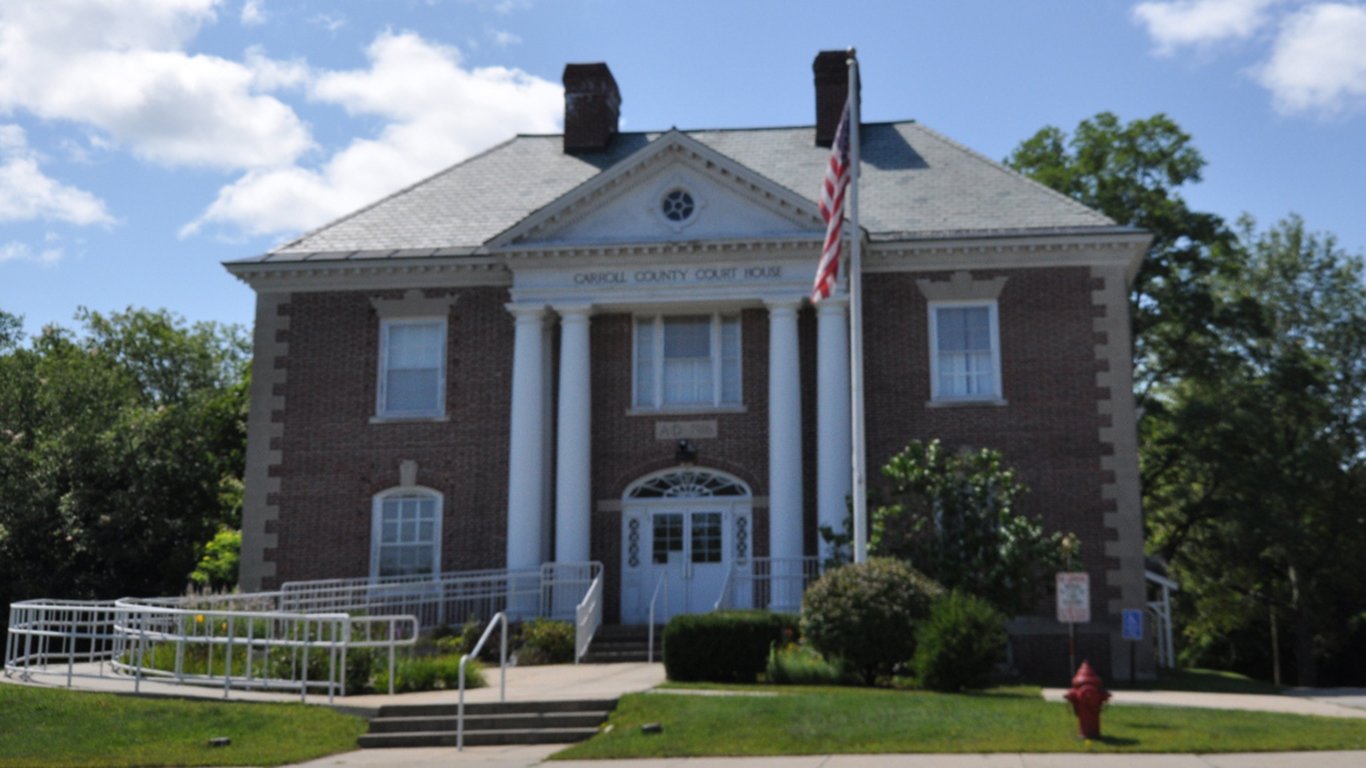
6. Carroll County, New Hampshire
> Population: 47,513
> Pct. of population 65+: 23.4%
> Avg. retirement income: $28,382
> No. of primary care physicians: 41
An estimated 23.4% of residents in Carroll County are at least 65 years old, one of the largest shares in the country. While older populations tend to have lower health outcomes, Carroll is one of the healthier counties in the country. Only 18.6% of the adult population does not engage in physical activity frequently, far less than the national inactivity rate of 22.0%. A larger share of seniors in Carroll County also receive regular preventive medical care than in a majority of U.S. counties. The majority of women aged 65 to 67 receive mammogram screenings — 70% had one in the past two years, more than the 63% national average. Some 88% of diabetic Medicare enrollees between the ages of 65 and 75 in the county receive tests that evaluate their long-term control of blood glucose concentrations annually, above the comparable nationwide rate of 85%.

5. Knox County, Maine
> Population: 39,723
> Pct. of population 65+: 21.4%
> Avg. retirement income: $23,366
> No. of primary care physicians: 39
The 65-and-over population in Knox County grew 2.4% over the past year due to inbound migration from out of state, more than double the national average. Some residents may relocate to Bartlett Woods, a retirement community in Rockland, the county seat, which caters to the active senior citizen. Knox is one of the most active counties nationwide, as only 17.9% of the adult population is physically inactive, which is far less than the 22.0% national inactivity rate. Physical activity helps one maintain a healthy body weight, and the county’s adult obesity rate is a low 23.1%. For perspective, the national rate is 28.0%. Obesity increases the risk of diabetes, specifically type 2 diabetes. The prevalence of diabetes is also very low in this county with 7.5% of the adult population diagnosed with the disease — among one of the lowest rates of any U.S. county.
[in-text-ad]
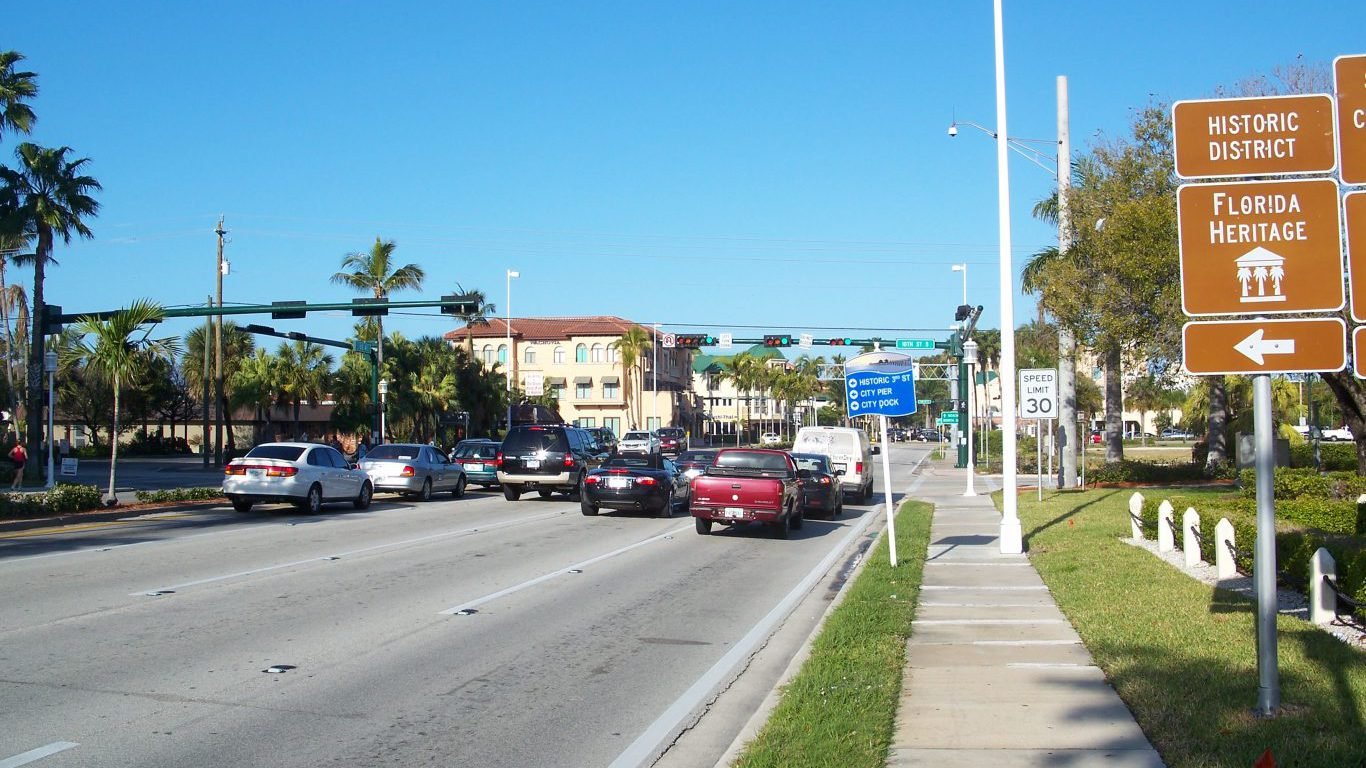
4. Collier County, Florida
> Population: 341,091
> Pct. of population 65+: 28.8%
> Avg. retirement income: $41,471
> No. of primary care physicians: 239
The 65-and-over population in Collier County, Florida increased by 3.7% in the past year due to inbound out-of-state migration, among the most of any county. Today, 28.8% of county residents are 65 years and older, more than double the 14.1% national rate. As one ages, obesity can become more commonplace. This county, however, has one of the lowest obesity rates of any U.S. county. Some 19.5% of adult residents are obese, far below the national obesity rate of 28.0%. Another perk for Collier County retirees is the ease of accessibility to opportunities for exercise — 91.3% of residents have access to locations for physical activity such as parks and recreational facilities, one of the largest shares nationwide.

3. Jefferson County, Washington
> Population: 30,083
> Pct. of population 65+: 30.1%
> Avg. retirement income: $28,417
> No. of primary care physicians: 26
The third healthiest retirement community in the nation is Jefferson County, Washington. Only 16.1% of the Jefferson County adult population is inactive, well below the national inactivity rate of 22.0%. Other notable healthy behaviors include the small percentage of residents who smoke at only 13.5% of the adult population — far less than the national smoking rate of 18.0%. Seniors in Jefferson County may also have greater access to preventive medical care. Some 90.5% of residents ages 65 to 75 with diabetes receive annual blood tests that monitor their long-term control of blood glucose concentrations, much higher than the comparable national average of 85.0%.

2. Beaufort County, South Carolina
> Population: 171,420
> Pct. of population 65+: 23.3%
> Avg. retirement income: $38,756
> No. of primary care physicians: 124
The 65-and-over population in Beaufort County, South Carolina increased by 5.0% due to inbound out-of-state migration that occurred over the past year, more than nearly any other county. Perhaps the antebellum architecture and natural surroundings are what draw retirees into the county, with its historic homes and scenic water views. Beaufort County contains Hilton Head Island and is roughly 45 miles from Savannah, Georgia — two great getaways. Residents of Beaufort County are quite active. Only 15.2% of adults do not exercise regularly, one of the smallest shares nationwide. In addition, seniors seem to receive more preventive care than in most counties. Some 74% of female Medicare enrollees ages 65 to 67 in Beaufort County are up to date on their biennial mammogram, well above the comparable national rate of 63%.
[in-text-ad-2]

1. San Juan County, Washington
> Population: 15,956
> Pct. of population 65+: 28.0%
> Avg. retirement income: $36,138
> No. of primary care physicians: 11
The healthiest community to retire in the United States is none other than San Juan County, Washington. The 65-and-over population increased by 1.9% due to seniors moving to the county from out of state, among the most of any county. San Juan is also one of the healthiest counties nationwide. Only 15.1% of the adult population in San Juan County is not physically active, far less than the national inactivity rate of 22.0%. Some 12.8% of adults in the county smoke and only 20.7% are obese, well below the national 18% smoking and 28.0% obesity rate. Residents also have greater access to mental health care. There are about 350 mental health providers per every 100,000 residents, well above the national concentration of 200 per every 100,000 Americans.
Detailed Findings & Methodology
The migration patterns of America’s older population can indicate where some of the top destinations for retirees are located. On average, the 65-plus population in the U.S. grew 1.1% over the past year from out-of-state migration. In our analysis, 24/7 Wall St. looked at the 90 counties where the 65-and-over population grew at least 1.7% from out-of-state migration in the last year and where they comprised at least 21.2% of the total county population — each 150% of the corresponding national figures.
24/7 Wall St. ranked those 90 counties with large elderly populations attracting new residents based on an index comprised of various measures related to health behaviors, health outcomes, and access to health care, such as physical activity, premature death, and the regularity of diabetes and breast cancer screening.
Regular physical exercise plays a significant role in one’s health. Routine physical exercise is important for senior citizens because as age increases, muscle mass and bone density decrease — both of which are important to maintain in order to execute daily activities independently. Nationwide, 32% of adults 65 and over engage in no leisure-time physical activity, the largest share of any age cohort and far more than the 22% inactivity rate for all adults over 20. While older populations tend to be less physically inactive, some retirement communities have far lower inactivity rates than the U.S. as a whole. In San Juan County, for example, the healthiest retirement community, just 15% of adults engage in no leisure-time activity, one of the smallest shares of any county nationwide.
Healthy behaviors can significantly reduce the likelihood of premature death. In the 500 counties with the oldest populations, approximately 7,500 years of life are lost per 100,000 residents annually to premature death before the age of 75 — far more than the national average of 6,600 potential years of life lost per 100,00 Americans. In some healthy elderly counties, however, the premature death rate is far below the U.S. average.
Having reliable access to health care is incredibly important for the elderly. One factor included in our health index is the share of diabetic Medicare patients aged 65 to 75 who received HbA1c tests in the past year. HbA1c is a test that evaluates a patient’s long-term control of his or her blood glucose concentration, and helps diabetes patients assess how well they have managed their condition in the past several months. The index also includes the share of female Medicare enrollees aged 65 to 67 who received a mammography screening in the past two years. Breast cancer is the most common type of cancer among U.S. women, and regular screenings can reduce the likelihood of mortality, especially among older women.
The healthiest retirement communities are often relatively wealthy. The average annual retirement income ranges from $63,000 per household in the wealthiest county to just $8,000 a year in the county with the lowest retirement earnings, and can be the difference between affording healthy food, physical instruction and therapy, and quality medical care. In 20 of the 25 healthiest retirement communities, the average annual household retirement income is greater than the $24,337 national average.
Many of the healthiest retirement communities also have well-educated senior populations. Americans with a college education often have more comfortable working conditions throughout their lifetime, which can have a major effect on longevity. Educated Americans are also more likely to retain cognitive ability and memory into old age, factors which can drastically affect one’s health. In 17 of 22 retirement communities on this list with education data, the share of the 65-plus population with a bachelor’s degree is greater than the 24.1% national share.
To identify the healthiest communities for retirement, 24/7 Wall St. constructed an index consisting of various health outcomes and health behaviors for counties with significant retirement populations. Data on the share of the population with diabetes in 2013 came from the Centers for Disease Control and Prevention and was included in the index with full weight. Data on the number primary care physicians, dentists, and mental health providers per 100,000 residents came from County Health Rankings & Roadmaps, a Robert Wood Johnson Foundation and University of Wisconsin Population Health Institute joint program, and were each given a one-third weighting in the index. Data on the number of social associations per 10,000 people, annual preventable hospitalizations per 1,000 Medicare enrollees, years of potential life lost per 100,000 residents annually, smoking rate, obesity rate, share of the population with access to opportunities for physical activity, share of diabetic Medicare patients aged 65 to 75 who received HbA1c tests in the past year, share of the female Medicare enrollees aged 65 to 67 who received a mammography screening in the past two years, and the share of residents who are physically inactive also came from County Health Rankings & Roadmaps and were included in the index and given a full weighting. Social associations per 10,000 residents and the share of the population with access to physical activity locations were given one-half weights, and the inactivity rate was given double weight. All data is from the most recent period available.
Only counties in which the share of the population aged 65 and older and the share of 65-year and older population that moved to the county from a different state in the past year were larger than 150% of the national values were considered. Data on the share of the population aged 65 and older and the share of the 65 and over population that moved to the county from a different state over the past year came from the U.S. Census Bureau’s American Community Survey and are 5-year averages for the period 2011 to 2015.
Take This Retirement Quiz To Get Matched With A Financial Advisor (Sponsored)
Take the quiz below to get matched with a financial advisor today.
Each advisor has been vetted by SmartAsset and is held to a fiduciary standard to act in your best interests.
Here’s how it works:
1. Answer SmartAsset advisor match quiz
2. Review your pre-screened matches at your leisure. Check out the
advisors’ profiles.
3. Speak with advisors at no cost to you. Have an introductory call on the phone or introduction in person and choose whom to work with in the future
Take the retirement quiz right here.
Thank you for reading! Have some feedback for us?
Contact the 24/7 Wall St. editorial team.
 24/7 Wall St.
24/7 Wall St. 24/7 Wall St.
24/7 Wall St. 24/7 Wall St.
24/7 Wall St.
